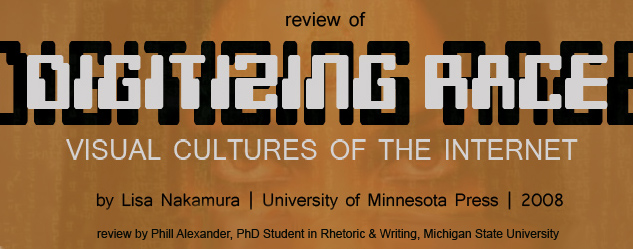

Introduction:
Digital Racial Formations
Chapter 1:
"Ramadan is Almoast Here"
Chapter 2:
Alllooksame
Chapter 3:
The Social Optics of Race
Chapter 4:
Avatars and Visual Culture
Chapter 5:
Measuring Race on the Internet
Epilogue:
Racio-Visual Logic
Conclusions on Digitizing Race
Many of these [demographic studies] design questions that hew to [the user as consumer] paradigm by querying respondents on what types of services and activities they engage in, rather than asking them about their cultural production, such as postings to bulletin boards or creation of websites or other forms of Internet textuality or graphic expression. (p. 172) Chapter 5 of Digitizing Race addresses the key issue of access, looking specifically at how users of color are viewed as consumers and not creators of digital media. This is, in many ways, a repeated theme in much of recent digital rhetoric, but that repetition simply underscores the profound importance of the differences in what is happening vs. what is being noted and what is idealized or marketed vs. what is transpiring. Nakamura focuses primarily on Asian and Asian American users in this chapter, talking not only about how they are perceived (as different from other non-whites in terms of the digital divide because they are perceived to have a favored position) and how they are represented. One particularly compelling case study is of the “Gay or Asian?” spread from Details, although it is not specifically digital reflects the influence of digital media and treats two non-heteronormative-white-American stereotypes in what is supposed to be a humorous—but ends up being derogatory—fashion. click for source and full image The move to examine carefully how the Internet is rapidly changing in terms of access—perceived and real—is critical to future studies in digital rhetoric. This chapter also represents a place where Nakamura’s (at times) seemingly distant case studies begin to truly gel across the span of the book; these visual representations of race that she discusses are all essentially simulacra in the Baudrillardian sense, and her analysis is an attempt to find the underpinning “reality,” or to at least move closer to it. In that sense it’s clever that one example deals with the remediation of a website as male desire for a woman, one deals with the remediation of the world as a piece of computer software, one deals with the inability to differentiate races by visual cue, and one deals with the extreme desire to embody and racialize visual cues of identity.
|
